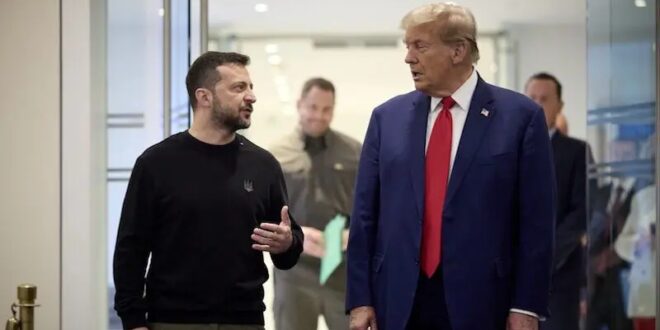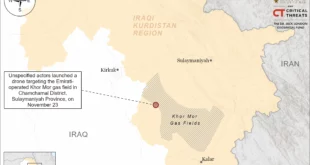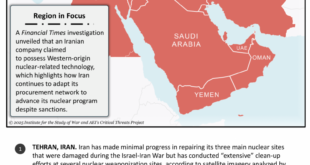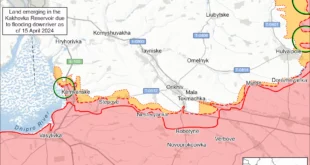A few weeks ago, rare earth elements, critical minerals, and other natural resources seemed like just one more factor in efforts to end Russia’s war on Ukraine.
Now they are front and center, a dominant focus of U.S. talks with Kyiv and a prominent vein of the intensifying diplomacy that also involves Moscow, the European Union, and others as Russia’s full-scale invasion enters its fourth year.
There were strong indications on February 25 that an agreement on a framework deal had been reached and that Ukrainian President Volodymyr Zelenskyy would be in Washington later this week to sign it.
The deal would cover the joint development of Ukraine’s critical minerals and other natural resources, such as oil and gas, according to multiple news reports quoting unidentified sources in the Ukrainian government. The reports said the agreement was a framework for a broad economic deal that would include the exploitation of rare earth minerals.
It was not immediately clear whether the agreement carries any specific U.S. security guarantees or if Washington has committed to sending additional military aid, Reuters reported. But one Ukrainian government official quoted by the Associated Press said that Kyiv hopes that signing the agreement will ensure the continued flow of U.S. military support that Ukraine urgently needs.
There was no formal confirmation from the U.S. side, but President Donald Trump said Zelenskyy wants to come to Washington to sign the deal.
“I hear that. I hear that he’s coming on Friday,” Trump told reporters at the White House, adding that Zelenskyy “would like to sign it together with me” and the deal on had been “pretty much negotiated.”
Bloomberg reported earlier that Ukraine’s cabinet is expected to recommend on February 26 that the deal be signed, and AFP quoted a senior Ukrainian official as saying the government was “working on the details” and “considering a visit to Washington for Friday to sign the agreement.” Reuters cited two sources it did not identify as saying Zelenskyy plans to travel to Washington on February 28 to meet with Trump.
The Financial Times cited Ukrainian officials as saying Kyiv is now ready to sign the agreement after the United States “dropped demands for a right to $500 billion in potential revenue from exploiting the resources.” It said the draft deal did not include specific U.S. security guarantees for Ukraine in the face of Russia’s assault, which had been one of Kyiv’s complaints about previous versions.
The reports of agreement on the terms came less than a month after Trump said on February 3 that his administration was “looking to a do a deal with Ukraine to secure what we’re giving them with their rare earth and other things.” His remarks sketched the bare outlines of a trade-off: U.S. aid, including the tens of billions of dollars in mostly military support that Washington has already provided, in exchange for access to critical minerals.
Since then, wrangling over a potential deal played into discussions at the February 14-16 Munich Security Conference and a starkly public exchange of criticism between Trump and Zelenskyy, who said he had rejected an initial U.S. proposal due in part to a lack of concrete security guarantees.
Trump Expecting Zelenskyy To Sign Mineral Deal
The White House redoubled its efforts to reach a deal with Kyiv in the wake of those developments, and on February 24 Trump said he expects Zelenskyy to come to Washington to sign an agreement sometime in the next two weeks. Earlier that day, Ukrainian Deputy Prime Minister Olha Stefanishyna said in a post on X that talks on the deal were in their “final stages” and “nearly all key details [have been] finalized.”
Hours later, Russian President Vladimir Putin abruptly added a new element to the transatlantic discussions about critical minerals in what looked like a bid to complicate the path toward a U.S.-Ukraine agreement. He chaired a high-level government meeting on rare earth metals and offered the United States a chance at joint exploration of Russia’s own deposits, adding: “We undoubtedly have, I want to emphasize, significantly more resources of this kind than Ukraine.”
Putin spoke after Trump hailed the possibilities for close U.S.-Russian economic cooperation in the event of a peace deal. He touched on a sensitive issue that is at the heart of his war against Ukraine and is likely to be a major bone of contention as efforts to end the war proceed, saying potential rare earth exploration deals could include deposits in Russian-occupied parts of eastern Ukraine, in the resource-rich region known as the Donbas.
On February 23, Ukrainian Deputy Prime Minister Yulia Svyrydenko told a news conference that “about $350 billion worth of these useful critical materials” are in Russian-occupied territory.
At 3.8 million metric tons, Russia’s rare earth reserves are the fifth-largest in the world, according to the U.S. Geological Survey. The main Russian rare earth mining and production companies have been nationalized since the start of the full-scale invasion of Ukraine and are now controlled by Rosatom, the state nuclear company, which has strong ties with close Putin associate Mikhail Kovalchuk, RFE/RL’s Russian investigative unit, Systema, reported on February 25.
Rare earths are a class of more than about 17 minerals — among them yttrium, cerium, and lanthanum — that are found in trace amounts throughout the Earth’s surface. They’re in increasing demand because of their use in products such as batteries, computers, smart phones, magnets, electric cars, and high-tech weaponry.
What Are Ukraine’s Mineral Resources?
Ukraine says it has reserves of half the 50 minerals the United States deems “critical to the U.S. economy and national security” — a broader category that includes lithium and titanium, among others — and of more common mineral resources such as coal, iron ore, oil, and gas.
U.S. officials have said that the minerals deal would enhance Ukraine’s security because the United States would want to protect its interests, but Zelenskyy has stressed that Kyiv needs strong and reliable security guarantees in the event of a cease-fire or peace deal.
In addition to concerns about security guarantees, the amounts the United States has mentioned have also caused consternation in Kyiv. Trump said earlier this month that he wanted “the equivalent of like $500 billion worth of rare earths,” and a new draft proposed by Washington after the rejection initially called for Ukraine to contribute to a U.S.-held fund until it reached that amount.
Zelenskyy has pointed out that American wartime aid so far has been far below $500 billion and that much of the money has gone to U.S. weapons producers. As of September, Congress had appropriated $174.2 billion in emergency supplemental funding for Ukraine-related purposes, with 64 percent of that going to the Defense Department and defense-related accounts, according to the Congressional Research Service.
The Financial Times said it had seen the “final version” of the agreement, which it said was dated February 24 and did not include a demand for $500 billion. The deal would “establish a fund into which Ukraine would contribute 50 percent of proceeds from the ‘future monetization’ of state-owned mineral resources, including oil and gas, and associated logistics,” the newspaper reported, and the fund would “invest in projects in Ukraine.”
According to the newspaper, the deal excludes mineral resources that already contribute to Ukrainian state coffers, “meaning it would not cover the existing activities of Naftogaz or Ukrnafta, Ukraine’s largest gas and oil producers.”
While the draft includes no specific security guarantees, AFP quoted a “senior Ukrainian source” as saying “there is a general clause that says America will invest in a stable and prosperous sovereign Ukraine, that it works for a lasting peace, and that America supports efforts to guarantee security.”
Existing EU-Ukraine Memorandum
Amid tension between the United States and the EU over Russia and the war in Ukraine, meanwhile, the news agency AFP reported that an EU official said the bloc had proposed a separate deal between the EU and Ukraine during a visit to Kyiv with European Commission President Ursula Von der Leyen on February 24, the third anniversary of the start of the full-scale invasion.
“Twenty-one of the 30 critical materials Europe needs can be provided by Ukraine in a win-win partnership,” AFP quoted the European commissioner for industrial strategy, Stephane Sejourne, as saying. “The added value Europe offers is that we will never demand a deal that’s not mutually beneficial.”
However, European Commission spokesman Thomas Regnier said on February 25 that there was “no proposal” from the EU, adding the bloc has had a partnership with Ukraine on critical minerals since a memorandum of understanding was signed in 2021.
Von der Leyen “reaffirmed [a] commitment to implement this memorandum of understanding and accelerate the work to strengthen our mutual benefit partnership,” he said. “As you see, this is really here about cooperation with Ukraine and not about any sort of competition with the United States.”
Speaking to RFE/RL on condition of anonymity, a senior EU official said he would be “surprised” if Von der Leyen and the European Commission “would want to challenge the U.S. on this.”
 Eurasia Press & News
Eurasia Press & News



